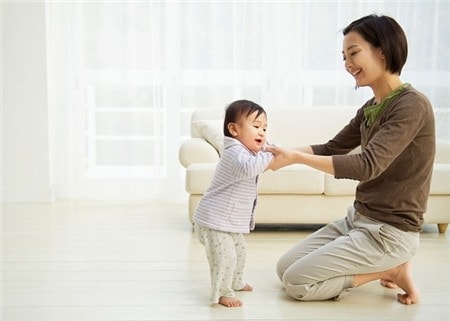Baby learning to walk and things that surprise you
Many parents are haunted by the question: “Is the baby walking yet?” or worry because the baby is slower than other babies. The first steps are different for each baby, usually from 9 to 15 months old.
1. The time when babies learn to walk is different.
Most babies start walking around 13 months old, but some start earlier (9-10 months) or later (15-16 months).
2. Three stages of baby learning to walk
- Sitting: At about 6 months old, the leg, arm, and neck muscles are strong enough for the baby to learn to sit.
- Propping up hands and lifting buttocks high: The time when babies can prop up hands and lift buttocks high is different for each baby, but is usually 10 months old.
- Standing with your hands on the chair: The time when your baby can stand with his hands on objects is different, depending on each baby. When your baby is curious about the surrounding objects, he will naturally lean his hands on them and practice standing.

The time it takes for each baby to walk is different. (Illustration photo)
3. First step
The first steps occur when the baby can lift one leg forward while balancing on the other. Of course, at first, the baby needs help from the parents.
Walking requires strong muscles and the baby learns to relax the hips and knees. The biggest difficulty is that the baby often tenses the knees when walking, which makes the balance fail; therefore, the baby is prone to falling (or you see the baby wobble).
From 12 months onwards, your baby's walking progresses quite quickly. You don't have to wait long because after a while, your baby can take his first steps around the house.
4. When your baby learns to walk early or late
It sounds ridiculous, but some parents mistakenly believe that if their children learn to walk early, they will learn better. Learning to walk early or late can affect the development of the child; accordingly, if the child is about 16 months old and still cannot walk, the parents should take the child to see a doctor. However, the relationship between early walking and being a genius needs further research. Some children learn to walk very quickly while others fall repeatedly. There are also children who take a long time to learn to walk. That is completely normal.
5. Factors affecting learning to walk
- Weight: Overweight babies often walk slower because they have difficulty maintaining balance when standing upright, compared to babies with moderate weight.
- Ear infection: If your baby is not walking by 16 months (or older), he may have an underlying medical condition. Ear infections can affect his balance, delaying his walking.
- Having an older sibling: Babies who learn to walk with an older sibling often learn to walk more quickly. Because a baby's natural instinct is to imitate, when they are with an older sibling, they will be interested in learning to walk.
6. Sometimes, the baby switches back to crawling.
Many babies, while learning to walk, like to combine learning to crawl with learning to walk. While walking, the baby suddenly changes its way and crawls quickly. Parents do not need to worry because in the early stages of learning to walk, the baby cannot distinguish between learning to walk and learning to crawl.
If your baby sees something interesting across the room, he or she will immediately be drawn to it and start crawling very quickly after it. Perhaps he or she is thinking, “Crawling will be faster. Walking is too slow.”
7. Hard to stop
The next challenge when a baby learns to walk is stopping so that he does not fall. Most babies who are just learning to walk fall while walking and then stop. Compared to adults, each step requires a lot of force because the baby does not know how to bend the knee, coordinate the heel and toes. In addition, the baby cannot apply the principle of stopping by stopping on one foot, bringing the other foot to a balanced position.
8. Let your baby learn to walk barefoot
Bare feet help babies walk easier than feet with shoes, because bare feet make the baby have direct contact with the floor (ground). If the baby walks on an unsafe surface, parents need to let the baby wear shoes. Choose shoes with flexible soles by trying to bend the baby's shoes, if the elastic material is good, then it is the right shoe.
According to Young Intellectuals - PC






